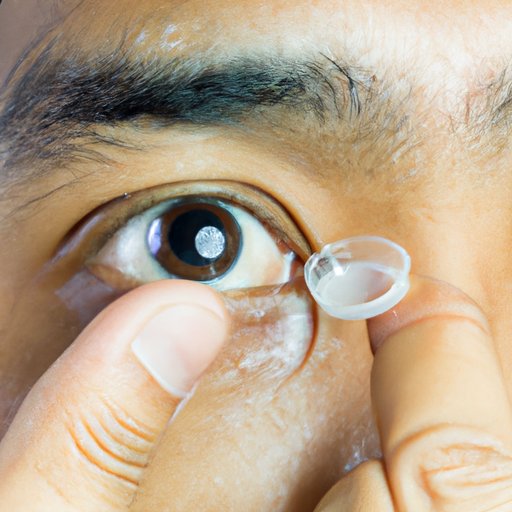Introduction
Eye infections can be uncomfortable and irritating, and they can also interfere with our daily activities. When you have an eye infection, one of the first questions on your mind may be how soon you can safely put in your contact lenses. The good news is that you don’t have to wait long before you can get back to wearing your contacts – but there are a few factors to consider before you do.
How Soon Can You Wear Contacts After an Eye Infection?
The amount of time you need to wait before putting in your contacts after an eye infection depends on several factors. For example, the type of infection you have will determine how long you should wait. Bacterial infections, for instance, may require more time than viral infections. Additionally, if you’re taking any antibiotics or other medications, you should wait until your treatment is complete before putting in your contacts.
In general, it’s recommended that you wait at least 24 hours after the infection clears up before putting in your contacts. This gives your eyes enough time to heal and recover from the infection.

The Dangers of Wearing Contacts Too Soon After an Eye Infection
Although you may be eager to get back to wearing your contacts, it’s important to understand the risks involved with doing so too soon. Wearing contacts too soon after an infection can increase your risk of re-infection or further irritation of the eye. In some cases, the infection may spread to the contact lens itself, which can lead to serious complications.
If you put in your contacts too soon after an infection, you may also experience redness, itching, or burning sensations in your eyes. If this occurs, you should remove your contacts immediately and consult your eye care professional for further guidance.
When Is It Safe to Wear Contact Lenses After an Eye Infection?
It’s important to wait until all symptoms of the eye infection have subsided before putting in your contacts. This includes any redness, inflammation, pain, itching, or discharge from your eyes. Additionally, you should wait until any medications prescribed by your doctor have been completed.
If you’re unsure about when it’s safe to wear your contacts, you should consult your eye care professional. They can evaluate your eyes and provide personalized advice on when it’s safe to put in your contacts.
Tips for Wearing Contacts After an Eye Infection
Once you’ve determined that it’s safe to wear your contacts, there are a few steps you can take to ensure your eyes stay healthy:
- Clean and disinfect your contacts properly. This means using the right cleaning solution and taking the necessary steps to keep your contacts clean throughout the day.
- Follow up with your eye care professional. Even if your eye infection has cleared up, it’s still a good idea to follow up with your eye doctor for a checkup.
- Avoid rubbing your eyes. Rubbing your eyes can irritate them and increase your risk of re-infection.

What You Should Know Before Putting in Contacts After an Eye Infection
Before putting in your contacts, it’s important to review the instructions provided by your eye care professional. This will ensure that you’re taking the necessary precautions to avoid re-infection or further irritation of your eyes.
Additionally, you should monitor your eyes for any signs of irritation or infection. If you experience any redness, itching, burning, or pain in your eyes, you should remove your contacts immediately and consult your eye care professional for further guidance.

Understanding the Risks of Wearing Contacts After an Eye Infection
Wearing contacts too soon after an eye infection can increase your risk of re-infection or permanent damage to your eyes. If you don’t wait long enough before wearing your contacts, you may experience further irritation or infection. In some cases, this can lead to vision loss or other serious complications.
It’s important to understand the risks of wearing contacts after an eye infection before putting in your contacts. If you’re unsure, you should consult your eye care professional for further guidance.
Conclusion
Eye infections can be uncomfortable and irritating, but you don’t have to wait long before you can put in your contacts again. It’s generally recommended that you wait at least 24 hours after the infection clears up before wearing your contacts. However, it’s important to take the necessary precautions to avoid further irritation or re-infection.
If you’re unsure about when it’s safe to wear your contacts, you should consult your eye care professional. They can evaluate your eyes and provide personalized advice on when it’s safe to put in your contacts. By understanding the risks and following the proper steps, you can ensure that you’re wearing your contacts safely after an eye infection.
(Note: Is this article not meeting your expectations? Do you have knowledge or insights to share? Unlock new opportunities and expand your reach by joining our authors team. Click Registration to join us and share your expertise with our readers.)
